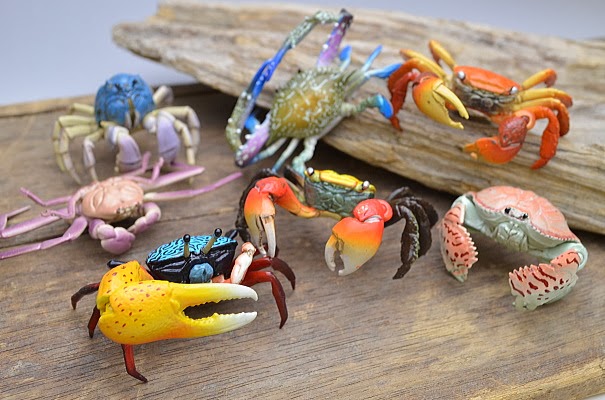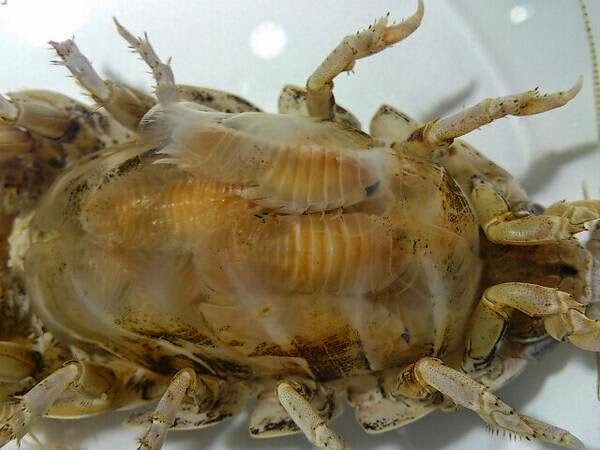![]()
As a big marine/deep-sea biology nerd, I've been following
the recent NOAA Gulf of Mexico Expedition undertaken by the Okeanos Explorer via the live stream on their website. For those who may not be familiar, the Research Vessel (R/V)
Okeanos Explorer deploys an ROV (Remotely Operated Vehicle) aka a robot submarine which can deploy to 6000 meters.
The ROV has cameras that basically broadcast a High definition signal back to the ship, which then provides the stream to everyone
via the Internet. You can see this here. The feed is usually narrated by two scientists who provide running commentary on the many biological and geological points of interest which they observe.
BUT they have a direct line to scientists on shore, who can instantaneously provide their expertise and/or knowledge without having to actually be on the ship. I am one of these experts and I've called in every so often to observe or point out some interesting and/or useful point.
Last year I was able to help provide some identifications and/or commentary for the 2013 Northeast Atlantic Canyons Expedition undertaken by the
Okeanos Explorer.
Go here to see a roundupThe current expedition was from April 10 to May 1st and its last cruise will be this week.
I've been watching their live feed as best as I can between various projects and day-to-day work. Many screengrabs and so forth have been made by several folks on Twitter, including myself (
@echinoblog), Dr. Chris Kellogg(
@DrChrisKellogg), the Voss Laboratory (
@VossLaboratory), Steve Auscavitch (
@steveauscavitch), NOAA Ocean Explorer (
@oceanexplorer) and of course, the
Okeanos Explorer itself (
@okeanosexplorer)...
BUT, the video feed can be long and filled with mostly uneventful transit and/or deep-sea bottoms until something interesting pops up! And even under the best of circumstances, important observations are missed and/or the ROV has to move on.....
So today, I've taken the liberty of rounding up 5 echinoderm-related observations condensed from the last 2 weeks of expedition video stream which I thougtht were interesting!! (sorry if you were more drawn to fishes, sedimentary structures or coral....)
These are presented here with my own personal comments on each! Enjoy!
5. Swimming Sea Cucumber Pooping!Swimming Sea Cucumbers! MANY were seen in the first couple of weeks of the expedition on the abyssal bottoms! (>2000 m depths). They in fact, saw many different species.
I've written about swimming sea cucumbers here... But perhaps one of the most photogenic and frequently seen is
Enypniastes. These live a combined bottom and swimming life. They live primarily on the bottoms, extending their mouth tentacles to the bottoms looking for fresh, organic (but nutritious!) goo which has fallen to the sea bottom...
When done, its off to the next! They take off in search of the next new spot with freshly fallen food!
![]()
But what made this
Okeanos observation so memorable??
Enypniastes was shot not only eating.. but DEFECATING!!!
You can see its intestine RIGHT THROUGH the transparent body! And that's the "cleaned" sediment pooping out of the end!
Shallow water sea cucumbers act in an ecological role similar to earthworms. They digest organic materials, leaving inorganic sediment which aids in aerating soil for other organisms. (see here for this).
Its likely that the processing of organics through these sea cucumbers is important for organic and carbon cycling on the deep-sea floor...
but here are FIVE good reasons why sea cucumber poop is so important! (not all reasons may apply to deep-sea species but these give you a good idea why seeing this happening is important).
4. Goniasterid starfish (Peltaster?) feeding on glass spongesAll throughout my PhD, I worked on goniasterid starfish. This is a family of sea stars with over 256 species! One of the most diverse among the Asteroidea. But there was maybe less than a dozen species that we knew anything about their biology or had even EVER seen alive.
What do they eat? What color are they alive? Most goniasterids live in deep-sea habitats and so, very few of them had ever been observed doing well...
anything, really.
So, every new observation, even anecdotally is potentially important and definitely interesting!
So, here we have a "cookie" shaped goniasterid, possibly
Peltaster or something related (positive ID unclear from the pics)... but hunched over some glass sponges upon which it is most likely feeding.
![]()
A closer look.... I can only wonder what it gets out eating a glass sponge which really doesn't have much in the way of tissue to digest...
3. Watching Dytaster insignis (Astropectinidae) & Nymphaster arentatus (Goniasteridae) ALIVE!When we talk about deep-sea starfishes, ESPECIALLY the ones that live below 2000 meters, we really don't know a lot about their biology. At one time, seeing ANY deep-sea starfish alive was biased by having to keep it in a cold-water aquarium AND by having to bring it up to the surface. RARELY have these species been seen alive, much less
in situ (i.e. in their natural setting)
But even basic questions were often unknown. What was its natural posture? What color was it when alive? What was it eating? What was it doing? How was it moving?
This species,
Dytaster insignis has been known primarily from dead specimens, usually with a gut, gouged full of mud similar to this porcellanasterid...
Here,
Dytaster insignis is alive and observed in the "wild" doing what it does naturally...This is probably one of the first times its been observed with such clarity..
What's MOST interesting about the next two shots is the disk? See how its swollen like that? Like its just about to pop?? You just don't get to see that in a preserved specimen.
Filled with mud? Sure. But probably also with water. Is the swelling just mud?
Is there perhaps more going on as there are with deep-sea sea cucumber guts??? (here)Another great starfish we got to see alive and
in situ (i.e. in its natural setting) is a goniasterid starfish species called
Nymphaster arenatus.
See those long arms? Always wondered what they were doing with em' Looks like they help to distribute the weight on the muddy bottoms?? Curious.
2. Mysterious 6-rayed starfish. Ampheraster alaminos or ???Perhaps the BEST of the various stories that come out of watching these videos is wondering which ones are possibly NEW species.
So, take this for example. Seen on this expedition in the Gulf of Mexico but ALSO on the North Atlantic cruise last year.
This 6-rayed star is a deep-sea species, from the Gulf of Mexico and superficially kind of looks like this rarely seen starfish
Ampheraster alaminos. Described only in 1971 (ha! I was only a year old!).
You can download this paper here.There is a WORLD of difference between seeing an animal living and seeing a 43 year old dead, dry specimen.
What's curious is that I've seen similar looking species (the reddish 6-rayed one) in the Pacific as well. Is this the SAME? Or just a similar appearance that superficially looks similar?? Unfortunately, the Okeanos does not yet collect specimens for examination. Could it be new?? So, we shall see some day....
1. What are Sea Urchins doing on Seep Mounds?Perhaps one of the most intriguing series of observations on this expedition came from a group that I don't personally work on: the sea urchins aka the echinoids.
So, early on in the dives the ROV spied these huge chemosynthetic communities, including MANY mussels as well as bacterial mats and other associated faunas...including these sea urchins (genus
Echinus perhaps? )
What's weird about this? Well, most echinoderms are pretty dang sensitive to water quality, especially when the water's filled with hydrocarbons or other unpleasant materials in it. So that's one thing. But okay... let's say they are tolerant, what's ANOTHER weird thing?....
What are they EATING?? When you take your basic Invertebrate Zoology course, you get told that "regular" urchins (
i.e., those which are ball shaped like this one vs. sand dollars, and etc.) mainly eat plant matter, kelp, etc. Now, I
've discussed in past posts how diverse the feeding modes of sea urchins can be...ranging from herbivores to filter feeders or even carnivores! But we don't see any of the usual food. So WHAT are they there for? Bacterial food? Perhaps something growing on the chemosynthetic mussels??
The urchins certainly look happy enough. So, one wonders what it is that makes their survivorship in this region possible?? When we wouldn't necessarily expect them to do well??
Interesting.
1a. BONUS Sea Urchins Feeding on Corals!First.. a big THANK YOU to Steve Auscavitch and the Voss Laboratory for capturing this image while I was off doing other things...
But yes. Sea urchins feeding on corals. We saw lots of this in the North Atlantic Okeanos expedition last year. It was new then and remains new here....
Extra Non-Echinoderm Observation: PALEODICTYON! These were traces observed on the deep-sea bottom. Its unclear exactly which organism creates them but similar traces have been see since the Paleozoic.
One famous oceanographer,
Dr. Peter Rhona made it a life obsession to find out what they were... (see this piece in the NYT).and another
account of these as "crop circles in the deep sea" at Hindered Settling. According to various sources on Twitter,
Paleodictyon was also a favorite topic of the famous
paleontologist Adolf Seilacher, who passed away recently..But what are they?? I don't know but by putting it out there again maybe someone out there will be intrigued and find out some day. Drop me a note when you find out!
P.S. Just to clarify, these bottom living brittle stars? Probably Ophiomusium. These don't live in corals unlike euryalid ophiuroids, which have the thick, branching fleshy arms arms and mostly live in the branches of various corals..
![]()
![]()













































































.jpg)






























_close-up.jpg)








